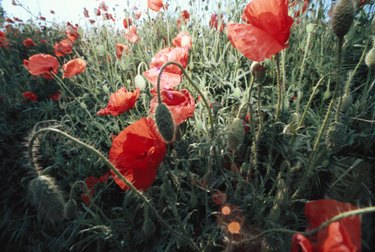
Poppies (Papaver spp.) are ornamental plants desired for their colorful flowers. Native to Eurasia, North Africa and the Americas, annual and perennial poppies grow in U.S. Department of Agriculture hardiness zones 2 to 10, depending on species and cultivar. While most poppies readily self-seed, some species will spread beyond your garden and invade surrounding meadows.
Tip
Most poppy species will readily self-seed and spread in the garden. Some also spread via their rhizomes and roots.
Video of the Day
About Poppy Plants
There are more than 120 poppy species in the genus Papaver. However, the family Papaveraceae contains another 25 genus, which contain several species also commonly known as poppies. In addition to the many poppy species, there are a number of cultivars that offer a wide range of flower and foliage combinations.
Video of the Day
These flowering plants, available as annual and perennial poppies, grow as ground-hugging 4-inch flowers or 4-foot upright clumps. Poppy flowers may only last one day or for a few days before they fade. Under favorable conditions, they spread in the home garden but are rarely invasive.
Self-Seeding in the Garden
Poppies typically spread through seed formation. The flowers die back and yield seed pods that mature in summer, then dry and shed seeds around the plant. Most poppy seeds are so tiny that they blow easily in the wind. Birds also eat the seeds and spread them.
Many poppies reseed easily, like the short-lived perennial California poppies (Papaver eschscholtzia), hardy in U.S. Department of Agriculture plant hardiness zones 8 through 10. They quickly spread across a hillside and may yield several generations in a season. Poppies self-sow in late summer or autumn and germinate the following spring.
Clumping and Mature Spread
Some poppies spread through roots that produce adjacent plants. Perennials such as the Oriental poppy (Papaver orientale), which thrives in USDA zones 3 through 7, can be left in place for years. They gradually spread into plant clumps that can be divided into new plants. They die back in late summer and foliage often disappears, only to emerge in spring from the root base.
Leave room around clumping poppies. They are not aggressive in crowding out other plants, but do need room to spread. If they are too large for the garden spot, divide the clumps and replant in bare spots in the garden. Alternatively, push a shovel into the soil around the plants to sever the roots and slow their growth.
Suckering Via Roots and Rhizomes
A few poppies, such as the California native Matilija poppy (Romneya coulter), spread aggressively through their roots in USDA zones 8 through 10. Matilija poppies grow through tenacious rhizomes or underground roots. Called the fried egg poppy for its yellow-centered white flower, this poppy grows into a shrub 4 feet or taller. It is a tough desert wildflower that survives drought and poor soil.
Matilija poppies spread into the surrounding area through a root network that puts up root suckers as new plants. It is hard to propagate from the seeds, which only germinate after a fire, but once established this type of poppy can take over a garden corner.
Harvesting Poppy Seed Flowers
Gather poppy seeds when the pods turn brown. Most poppy pods resemble small globes or urns. The seeds mature inside. Remove them by shaking the pod upside down so the seeds fall from the holes or crush the dry pod and sift out the tiny round seeds.
The California poppy matures into a slender pod 1 to 2 inches long. Snip off these pods before they are fully ripe and drop them in a paper bag or covered container. When each pod is dry and brittle, it spontaneously pops open and scatters seeds several feet. The slightest touch to a dry pod will snap it open and throw seeds to the ground.